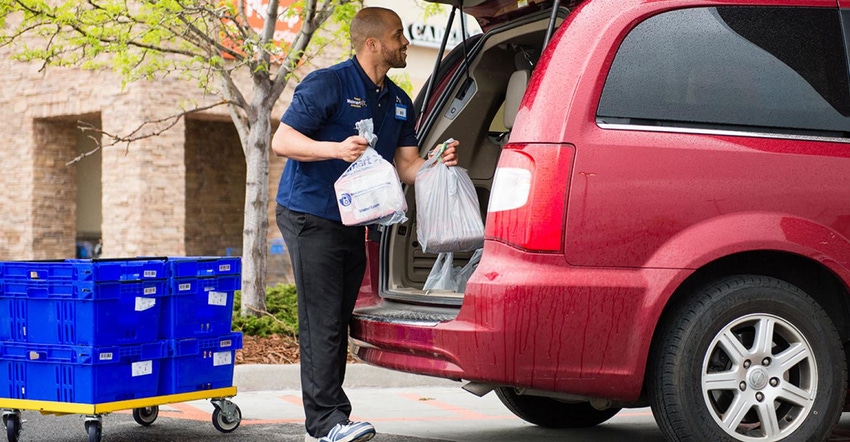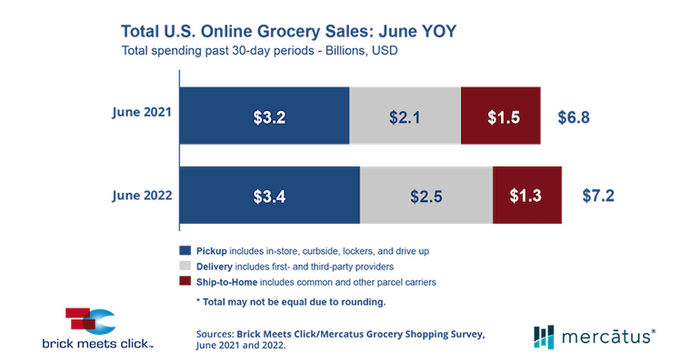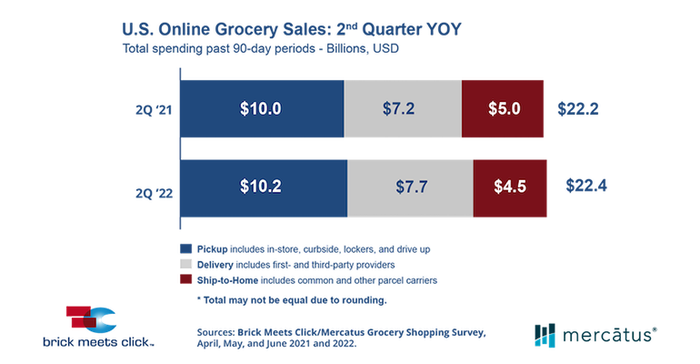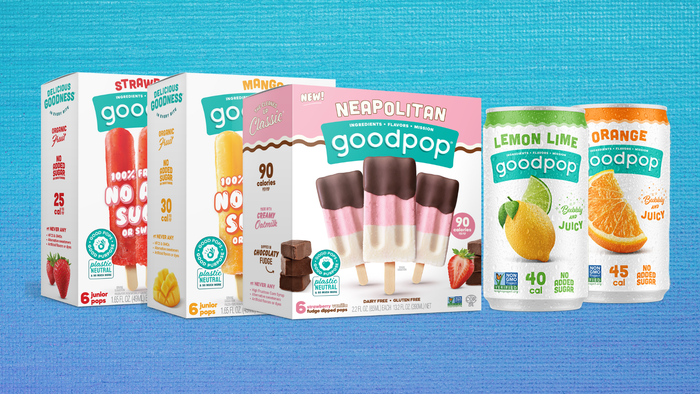Online grocery sales in June rise after recent sequential decreases
Inflation is prompting consumers to carefully watch prices, while COVID-19 variants are pushing them to avoid in-person shopping, a Brick Meets Click partner says.
July 15, 2022

U.S. online grocery sales swung back up for June following sequential decreases in the previous two months, according to the latest Brick Meets Click/Mercatus Grocery Shopping Survey.
Sales for the U.S. online grocery market came in at $7.2 billion in June, up 1.4% from $7.1 billion in May, when sales were down 12.3% from $8.1 billion in April. The market in April also marked a 6.9% month-to-month decrease from $8.7 billion in March.
Year over year, June e-grocery sales rose 5.9% from $6.8 billion. May e-grocery sales also had edged up 1.7% after declines of 3.8% in April and 6.5% in March.

Online grocery sales via pickup hit $3.4 billion in June, up nearly 6.3% from the previous month as well as in June 2021, when sales for each period totaled $3.2 billion. Delivery sales were flat sequentially at $2.5 billion for June but were up 19% from $2.1 billion in the year-ago period.
For the 2022 second quarter, total U.S. e-grocery sales were $22.4 billion, up 0.9% from $22.2 billion in the 2021 second quarter but down 13.5% from $25.9 billion in the 2022 first quarter. On a year-over-year basis, Q2 pickup sales advanced 2% to $10 billion (versus a 2% decrease in Q1), while Q2 delivery sales grew 6.9% to $7.7 billion (versus a 15% gain in Q1).
By wallet share of the total grocery market, online grocery ended the 2022 second quarter at 13.6%, up 1.5 percentage points versus a year ago. Excluding ship-to-home (since most conventional grocers don't offer this service), delivery and pickup combined to contribute 10.9% during the quarter, up from 9.3% last year.
An expanding monthly active user (MAU) base and higher average order values (AOVs) were offset by lower order frequency among its MAUs during both June and the second quarter, Brick Meets Click said. For Q2, pickup contributed 45.7% of total online grocery sales, up 80 basis points from 2021.
Delivery captured 34.2% of online grocery dollar share in Q2, up 1.7 percentage points from 2021. Brick Meets Click noted that delivery has benefited from a range of new service options and features that have enlarged the size of its addressable market and spurred more usage occasions. The Barrington, Illinois-based strategic advisory firm said delivery's monthly sales jumped over 20%, and it closed out Q2 at 6% higher than year-ago results. Gains in the MAU base during the quarter and in June fueled most of the sales lift, though higher AOVs also were a catalyst in the year-over-year gains. Delivery produced mixed results relative to order frequency, as frequency rose during June but declined for the quarter.

"Inflation and COVID are creating cross-currents in the market as higher prices motivate customers to look for ways to avoid paying more than necessary," according to David Bishop, partner at Brick Meets Click, which focuses on how digital technology impacts food sales and marketing. "And ongoing concerns about contracting the virus motivate shoppers to use online grocery as a way to stay healthy. This is especially true as new variants of the virus triggered surges in infection and rising illness rates during May and June."
Conducted June 29 and 30 by Brick Meets Click, and sponsored by grocery e-commerce specialist Mercatus, the survey polled 1,743 U.S. adults who participated in their household's grocery shopping and made an online grocery purchase in the previous 30 days. Delivery includes retailer and third-party services (e.g. Instacart, Shipt), while pickup includes in-store, curbside, locker and drive-up services. Ship-to-home sales cover online grocery purchases delivered by parcel couriers like Federal Express, UPS and the U.S. Postal Service.
In both June and the second quarter, the ship-to-home channel extended a long-term decline that began at the pandemic's onset in March 2020, when COVID-19 sparked a boom in e-grocery shopping, Brick Meets Click said. Ship-to-home sales fell 7.1% month to month and 13.3% year over year to $1.3 billion in June and were down over 10% in Q2 (versus a 29% drop in Q1). The segment's MAU base expanded in both June and the second quarter, but consistently lower AOVs drove the sales decline as did a slight contraction in the number of orders placed each month, the study showed. Ship-to-home dollar share in Q2 was 20%, down 2.6 percentage points from a year earlier.
E-grocery cross-shopping between grocery and mass retail channels tailed off to 27% for June, about 1.5 percentage points lower than a year ago, likely reflecting fewer households shopping mass merchants during the month, Brick Meets Click reported. The Q2 share of grocery's MAU base that also shopped online with mass came in at 28%, up just over a percentage point versus the 2021 quarter.
Repeat intent, or the likelihood of an online grocery shopper to use the same service again within the next month, held steady at 63% in June and the second quarter. As a result, this year's second quarter average repeat intent rate climbed 7 points versus the same period a year ago. For June, the grocery rate continued to trail mass by 8 percentage points, which Brick Meets Click said highlights the gap that grocers still need to close to safeguard their core customers.
"Despite the current inflationary environment, a significant number of grocery customers continue to shop using online channels," observed Sylvain Perrier, president and CEO of Toronto-based Mercatus. "Customers crave convenience, but they also want to find ways to save money. Encouraging customers to use lower-priced pickup services is one opportunity. Elevating and showcasing private-label products online is another. Also consider integrating digital coupons into your first-party web and mobile experiences."

About the Author(s)
You May Also Like




